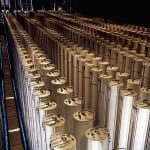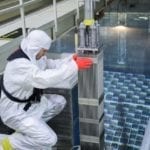Three nations participating in the Nuclear Security Summit hosted by the Obama Administration in Washington, D.C. this week have agreed to turn over highly enriched uranium (HEU), likely to the U.S. As a result, Ukraine and Mexico will be switching from power plants fueled by HEU to ones fueled by low-enriched uranium (LEU). These commitments follow a secret and at times challenging effort to convey HEU from Chile to the U.S. that was complicated by the earthquake there in February.
Yucca Mountain may no longer be a viable repository for high-level nuclear waste, but high-level nuclear material from both military and civilian programs is headed to the U.S. and possibly Russia. The move is part of the Obama administration’s efforts to advance nuclear nonproliferation goals and keep fissile materials out of the hands of terrorist organizations and individuals.
Several international organizations concerned with nuclear materials and 47 countries were represented at the two-day summit that began on Monday. The meeting was the fulfillment of a goal that President Obama set a year ago in Prague when he called for “a new international effort to secure all vulnerable nuclear materials around the world in four years." President Lee of South Korea has agreed to host the next Nuclear Security Summit in the Republic of Korea in two years.
Canada to Send HEU Back to U.S.
On Monday, Canadian President Stephen Harper announced that Canada would ship an 11-year stockpile of HEU spent fuel from the Chalk River Laboratories to the U.S. over the next eight years. The Canwest News Service quoted Harper as saying, "While all of this material is obviously highly secure in Canada, this was highly enriched uranium (that) originated in the United States. . . . It’s our view that the best thing for all countries to do—not just ourselves—is to return such material to their countries [of] origin."
A Canadian government official noted that Canada will Canada continue to maintain a supply of HEU to produce medical isotopes for radiation therapy.
Ukraine Announces Divestment of HEU
In a Monday press briefing, White House Press Secretary Robert Gibbs announced that Ukraine had committed to rid itself "of all of its stockpile of highly enriched uranium by the time of the next Nuclear Security Summit in 2012. Ukraine intends to remove a substantial part of its stocks this year. Ukraine will convert its civil nuclear research facilities—operate with low-enriched uranium fuel. This is something that the United States has tried to make happen for more than 10 years. The material is enough to construct several nuclear weapons. And this demonstrates Ukraine’s continued leadership in non-proliferation and comes in an important region where we know a lot of highly enriched uranium exists."
One question from the press corps noted that when CNN did an interview with the President of Ukraine, he said that his nation’s HEU would be going to Russia. Though there was speculation that nuclear material originating in the U.S. would return to the U.S. and material originating in Russia would return to that country, Gibbs insisted that details about the final disposition of the material had not been confirmed.
The Storage Location Question
Gibbs was asked if the president is concerned that the U.S. would become "a global storage facility for these materials? And if so, don’t you have another Yucca Mountain with international implications here?" Gibbs responded that "the goal of this summit and the reason the President is so concerned about it is our genuine concern about the security environment in which this material is held. We don’t worry about the security environment with which that material is held in this country, whether that’s in different places around the country."
Gibbs also noted later that the HEU headed to the U.S. is not the sort of nuclear material that the now-defunct Yucca Mountain repository was intended to store.
As for what might be done with the HEU, Gibbs said: "the final disposition could easily take the form of a low-enriched uranium in order to provide for the use in a peaceful nuclear program. I certainly think that is … one of the disposition ideas. Again, because this [Ukraine announcement] is a fresh announcement, the final resting place for that material—some of it may be here, some of it may not be here.
"My answer … was simply to say I think when forced with the choice of having that material stored safely here or taking the risk that it may or may not be secured somewhere else, particularly in highly volatile regions in the world, our choice quite clearly is to have that here."
Mexico to Convert Power Plants from HEU to LEU
Next to join the list of countries willing to turn over its HEU: Mexico. In a Tuesday press release, the White House said:
Mexico, the United States, and Canada reached agreement to work together, along with the International Atomic Energy Agency (IAEA), to convert the fuel in Mexico’s research reactor. President Calderon expressed "the strong commitment of Mexico to prevent and suppress nuclear terrorism; with this kind of cooperation with the IAEA and our North American partners, we definitely contribute to reducing the risks associated with illicit trafficking of nuclear materials."
The three countries acknowledged that this project also provides an important step towards the replacement of the research reactor with a new low-enriched uranium fuelled reactor in support of Mexico’s nuclear energy development.
The conversion of the reactor’s use of highly enriched uranium (HEU) to low enriched uranium (LEU) fuel will enable the elimination of all the remaining highly enriched uranium from Mexico. This effort, a specific outcome of Nuclear Security Summit, will be completed under the auspices of the IAEA. It will further strengthen nuclear security on the North American continent.
President Obama indicated, "I welcome this critical step forward, which is a signal of our strong trilateral partnership, and our shared commitment to nuclear security in North America." Prime Minister Harper added that "this nuclear security project demonstrates that collective action can deliver concrete results".
Chilean HEU Removed
On April 8, just prior to the summit in Washington, the National Nuclear Security Administration (NNSA) announced that it had removed all HEU from Chile, making it the fifth country to remove all of its HEU since President Obama called for an international effort to secure all vulnerable nuclear material around the world within four years. The operation in Chile was successfully completed despite a massive earthquake on Feb. 27 and numerous aftershocks that occurred while the NNSA team was in the country.
The NNSA and Chilean Commission of Nuclear Energy removed 13.6 kilograms of HEU spent fuel from the La Reina Nuclear Center in downtown Santiago, Chile, along with 4.3 kilograms of slightly irradiated HEU and 0.3 kilograms of fresh fuel from the Lo Aguirre Nuclear Center located 40 km west of Santiago, and more than 400 U.S.-origin radiological sources.
The material was packaged into internationally licensed transportation casks, secured in shipping containers and transported in an armed convoy from the reactor sites to a nearby port for transport by sea to the U.S. The shipment was recently completed after the vessels arrived at a secure U.S. port in late March. The material was then delivered by flatbed trucks to the Savannah River Site in South Carolina and the Y-12 National Security Complex in Oak Ridge, Tennessee for reprocessing. Photos of the removal effort are available form the NNSA website.
The project was part of the NNSA’s Global Threat Reduction Initiative (GTRI). To date, the GTRI has removed all significant amounts of HEU from 18 countries.
Summit Statements
For its part, the U.S. has been reducing its number of HEU-fueled reactors. The U.S. statement at the close of the summit notes that, "In 2009, the United States completed conversion of all 20 of our highly-enriched-uranium-fueled reactors that could be converted to use low enriched uranium fuel. There are six remaining highly-enriched-uranium-fueled reactors in the United States that will be converted to use low enriched uranium fuel once acceptable fuel has been developed."
For more summit details, see the documents and statements released late Tuesday.
Sources: whitehouse.gov, Canwest News Service, NNSA










